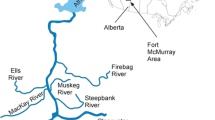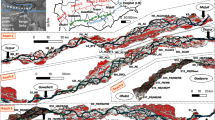Abstract
Purpose
The preferential erosion, delivery, and transport of sediment within a drainage basin can result in downstream changes in both particle size and organic matter content. The physical and biological properties of transported and deposited sediment are important considerations in many sediment management and investigative tools, including sediment fingerprinting, and aid in the interpretation of sediment-associated nutrient and contaminant data.
Materials and methods
A recirculating flume (2 × 2 × 40 m) was used to assess the changes in particle size, organic matter content, and geochemical composition of fine-grained sediment (<125 μm) over a 31-h period (representing a travel distance of ∼24 km) under three contrasting channel bed conditions. The three channel gravel bed conditions investigated were 0-, 5-, and 40-cm gravel bed depths. Suspended sediment samples were collected throughout the duration of the experiment and gravel-stored sediment were collected along the length of the flume at the end of the experiment. Both suspended and gravel-stored sediment were analyzed for particle size and organic matter content. In addition, suspended sediment samples were analyzed for a broad suite of geochemical elements.
Results and discussion
The channel bed characteristics had a significant effect on both the particle size and organic matter selectivity of the transported suspended sediment. Furthermore, it was shown that a smooth planar channel bed as compared to a planar gravel bed (i.e., 0- vs. 5-cm gravel treatments) introduced small-scale roughness which resulted in the preferential deposition of larger particles into the channel bed. Increasing the gravel bed from 5 to 40 cm increased the amount of intra-gravel flow and reduced the potential for resuspension resulting in a further reduction in the particle size as well as resulting in a significant increase in the organic matter content of the suspended sediment. The relation between geochemical concentrations and particle size of the suspended sediment, in terms of linearity, magnitude, and direction, were not consistent between the different elements investigated.
Conclusions
This research helps to understand the processes that control the particle size and organic matter selectivity of fluvial transported sediment. This information is an important part of many sediment management tools, including sediment fingerprinting, as it provides context when selecting sampling sites and interpreting the data they provide. The inconsistent relation between particle size and the concentration of different geochemical elements highlights the uncertainty associated with commonly used particle size correction factors.






Similar content being viewed by others
References
Albers SJ, Petticrew EL (2012) Ecosystem response to a salmon disturbance regime: implications for downstream nutrient fluxes in aquatic systems. Limnol Oceanogr 57:113–123
Angers DA, Bullock MS, Mehuys GR (2007) Aggregate stability to water. In: Carter MR, Gregorich EG (eds) Methods of soil analysis, 2nd edn. CRC Press, Boca Raton, pp 811–819
Arcement GJ, Schneider VR (1989) Guide for selecting manning’s roughness coefficients for natural channels and flood plains. Report 2339. U.S. Department of Transportation, Federal Highway Administration, Reston
Bainbridge ZT, Lewis SE, Smithers SG, Kuhnert PM, Henderson BL, Brodie JE (2014) Fine-suspended sediment and water budgets for a large, seasonally dry tropical catchment: Burdekin River catchment, Queensland, Australia. Water Resour Res 50:9067–9087
Brady NC, Weil RR (2001) The nature and properties of soils, 13th edn. Prentice Hall, New Jersey
Cole JJ, Prairie YT, Caraco NF, McDowell WH, Tranvik LH, Striegle RG, Duarte CM, Kortelainen P, Downing JA, Middleburg JJ, Melack J (2007) Plumbing the global carbon cycle: integrating inland waters into the terrestrial carbon budget. Ecosystems 10:172–185
Collins AL, Walling DE, Leeks GJL (1997) Source type ascription for fluvial suspended sediment based on a quantitative composite fingerprinting technique. Catena 29:1–27
Davis CM, Fox JF (2009) Sediment fingerprinting: review of the method and future improvements for allocating nonpoint source pollution. Environ Eng 135:490–504
Di Stefano C, Ferro V (2002) Soil and water: linking clay enrichment and sediment delivery processes. Biosyst Eng 81:465–479
Droppo IG (2001) Rethinking what constitutes suspended sediment. Hydrol Process 15:1551–1564
Droppo IG, Leppard GG, Flannigan DT, Liss SN (1997) The freshwater floc: a functional relationship of water and organic and inorganic floc constituents affecting suspended sediment properties. Water Air Soil Pollut 99:43–53
Duiker SW, Rhoton FE, Torrent J, Smeck NE, Lal R (2003) Iron (hydr)oxide crystallinity effects on soil aggregation. Soil Sci Soc Am J 67:606–611
Fryirs K (2013) (Dis)Connectivity in catchment sediment cascades: a fresh look at the sediment delivery problem. Earth Surf Process Landforms 38:30–46
Garzon-Garcia A, Olley JM, Bunn SE (2015) Controls on carbon and nitrogen export in an eroding catchment of south-eastern Queensland, Australia. Hydrol Process 29:739–751
Gibson S, Heath R, Abraham D, Schoellhamer D (2011) Visualization and analysis of temporal trends of sand infiltration into a gravel bed. Water Resour Res 47, W12601
Grams PE, Wilcock PR (2014) Transport of fine sediment over a coarse, immobile riverbed. J Geophys Res:Earth 119:188–211
Hamm NT, Dade WB, Renshaw CE (2011) Fine particle deposition to porous beds. Water Resour Res 47, W11508
Hjulström F (1935) Studies of the morphological activity of rivers as illustrated by the River Fyris. Bull Geol Instit Uppsala 25:221–527
Horowitz AJ (1991) A primer on sediment-trace element chemistry, 2nd edn. Lewis Publishers, Chelsea
Kerr JG, Burford MA, Olley JM, Bunn SE, Udy J (2011) Examining the link between terrestrial and aquatic phosphorus speciation in a subtropical catchment: the role of selective erosion and transport of fine sediments during storm events. Water Res 45:3331–3340
Kirkgöz MS (1989) Turbulent velocity profiles for smooth and rough open channel flow. J Hydraul Eng 115:1543–1561
Koiter AJ, Owens PN, Petticrew EL, Lobb DA (2013a) The behavioural characteristics of sediment properties and their implications for sediment fingerprinting as an approach for identifying sediment sources in river basins. Earth-Sci Rev 125:24–42
Koiter AJ, Lobb DA, Owens PN, Petticrew EL, Li S, Tiessen KHD (2013b) Investigating the role of connectivity and scale in assessing the sources of sediment in an agricultural watershed in the Canadian prairies using sediment source fingerprinting. J Soils Sediments 13:1676–1691
Kroetsch D, Cang C (2007) Particle size distribution. In: Carter MR, Gregorich EG (eds) Soil sampling and methods of analysis, 2nd edn. CRC Press, Boca Raton, pp 713–727
Laceby JP, McMahon J, Evrard O, Olley J (2015) A comparison of geological and statistical approaches to element selection for sediment fingerprinting. J Soils Sediments. doi:10.1007/s11368-015-1111-9
Maskaoui K, Zhou JL (2010) Colloids as a sink for certain pharmaceuticals in the aquatic environment. Environ Sci Pollut Res 17:898–907
Naden PS (2010) The fine-sediment cascade. In: Burt TP, Allison RJ (eds) Sediment cascades: an integrated approach. Wiley, Chichester, pp 271–305
Ockenden MC, Deasy C, Quinton JN, Surridge B, Stoate C (2014) Keeping agricultural soil out of rivers: evidence of sediment and nutrient accumulation within field wetlands in the UK. J Environ Manage 135:54–62
Oliver DM, Clegg CD, Heathwaite AL, Haygarth PM (2007) Preferential attachment of Escherichia coli to different particle size fractions of an agricultural grassland soil. Water Air Soil Pollut 185:369–375
Packman AI, Salehin M (2003) Relative roles of stream flow and sedimentary conditions in controlling hyporheic exchange. Hydrobiologia 494:291–297
Petticrew EL, Krein A, Walling DE (2007) Evaluating fine sediment mobilization and storage in a gravel-bed river using controlled reservoir releases. Hydrol Process 21:198–210
Pulley S, Foster I, Antunes P (2015) The application of sediment fingerprinting to floodplain and lake sediment cores: assumptions and uncertainties evaluated through case studies in the Nene Basin, UK. J Soils Sediments. doi:10.1007/s11368-015-1136-0
R Core Team (2015) R: A language and environment for statistical computing. R Foundation for Statistical Computing. http://www.R-project.org
Rehg KJ, Packman AI, Ren JH (2005) Effects of suspended sediment characteristics and bed sediment transport on streambed clogging. Hydrol Process 19:413–427
Rex JF, Petticrew EL (2008) Delivery of marine-derived nutrients to streambeds by Pacific salmon. Nat Geosci 1:840–843
Rex JF, Petticrew EL (2010) Salmon-derived nitrogen delivery and storage within a gravel bed: sediment and water interactions. Ecol Eng 36:1167–1173
Rhoton FE, Emmerich WE, Goodrich DC, Miller SN, McChesney DS (2006) Soil geomorphological characteristics of a semiarid watershed. Soil Sci Soc Am J 70:1532
RStudio (2015) RStudio: integrated development environment for R. http://www.rstudio.org/
Russell MA, Walling DE, Hodgkinson RA (2001) Suspended sediment sources in two small lowland agricultural catchments in the UK. J Hydrol 252:1–24
Sherriff SC, Franks SW, Rowan JS, Fenton O, Ó’hUallacháin D (2015) Uncertainty-based assessment of tracer selection, tracer non-conservativeness and multiple solutions in sediment fingerprinting using synthetic and field data. J Soils Sediments. doi:10.1007/s11368-015-1123-5
Shields A (1936) Anwendung der Aehnlichkeitsmechanik und der urbulenzforschung auf die eschiebebewegung. Mitteilung der preussischen Versuchsanstalt fur Wass erbau und Schiffba, Berlin
Slager A (2014) Hyporheic exchange inside a flat gravel bed, flume experiments and modelling. M.Sc. thesis, Utrecht University. Netherlands
Slattery MC, Burt TP (1997) Particle size characteristics of suspended sediment in hillslope runoff and stream flow. Earth Surf Process Landforms 22:705–719
Smith HG, Blake WH (2014) Sediment fingerprinting in agricultural catchments: a critical re-examination of source discrimination and data corrections. Geomorphology 204:177–191
Stone PM, Walling DE (1997) Particle size selectivity considerations in suspended sediment budget investigations. Water Air Soil Pollut 99:63–70
Tranvik LJ, Downing JA, Cotner JB, Loiselle SA, Striegl RG, Ballatore TJ, Dillon P, Finlay K, Fortino K, Knoll LB (2009) Lakes and reservoirs as regulators of carbon cycling and climate. Limnol Oceanogr 54:2298–2314
Walling DE (1983) The sediment delivery problem. J Hydrol 65:209–237
Walling DE (2005) Tracing suspended sediment sources in catchments and river systems. Sci Total Environ 344:159–184
Walling DE, Webb BW, Woodward JC (1992) Some sampling considerations in the design of effective strategies for monitoring sediment-associated transport. In: Bogen J, Walling DE, Day TJ (eds) Erosion and sediment transport monitoring programmes in river basins. IAHS Publ. no. 210. IAHS Press, Wallingford, pp 279–288
Wickham H (2009) ggplot2: elegant graphics for data analysis. Springer, New York
Wilkinson SN, Olley JM, Furuichi T, Burton J, Kinsey-Henderson AE (2015) Sediment source tracing with stratified sampling and weightings based on spatial gradients in soil erosion. J Soils Sediments. doi:10.1007/s11368-015-1134-2
Withers P, Jarvie H (2008) Delivery and cycling of phosphorus in rivers: a review. Sci of Total Environ 400:379–395
Wooster JK, Dusterhoff SR, Cui Y, Sklar LS, Dietrich WE, Malko M (2008) Sediment supply and relative size distribution effects on fine sediment infiltration into immobile gravels. Water Resour Res 44, W03424
Xu H, Lu J, Liu X (2008) Non-uniform sediment incipient velocity. Int J Sediment Res 23:69–75
Young R, Huryn A (1997) Longitudinal patterns of organic matter transport and turnover along a New Zealand grassland river. Freshwater Biol 38:93–107
Zheng Y, Luo X, Zhang W, Wu B, Han F, Lin Z, Wang X (2012) Enrichment behavior and transport mechanism of soil-bound PAHs during rainfall-runoff events. Environ Pollut 171:85–92
Zingg T (1935) Beitrag zur schotteranalyse. Schweizerische mineralogische und petrologische mitteilungen 15:39–140
Acknowledgments
The first author is supported by the Natural Science and Engineering Research Council (NSERC) of Canada through the Alexander Graham Bell Canada Graduate Scholarship Program. This work is funded by a NSERC Strategic Grant—Development of environmental fingerprinting techniques for sources of sediment and associated phosphorus within agricultural watersheds of Canada—to DAL, PNO, and ELP. The authors would also like to acknowledge the Quesnel River Research Centre (QRRC) and the Landscape Ecology Research Group staff and students for the use of the facilities and equipment as well as technical support. This paper comprises part of the QRRC Publication Series.
Author information
Authors and Affiliations
Corresponding author
Additional information
Responsible editor: Hugh Smith
Rights and permissions
About this article
Cite this article
Koiter, A.J., Owens, P.N., Petticrew, E.L. et al. The role of gravel channel beds on the particle size and organic matter selectivity of transported fine-grained sediment: implications for sediment fingerprinting and biogeochemical flux research. J Soils Sediments 15, 2174–2188 (2015). https://doi.org/10.1007/s11368-015-1203-6
Received:
Accepted:
Published:
Issue Date:
DOI: https://doi.org/10.1007/s11368-015-1203-6




